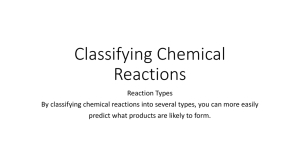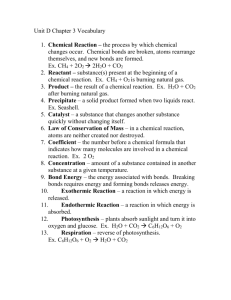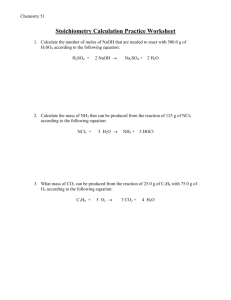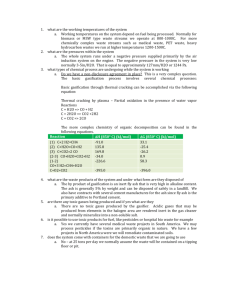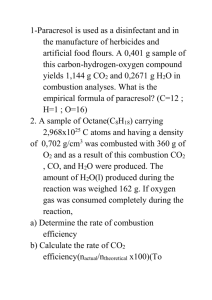Chemistry and Energy
advertisement
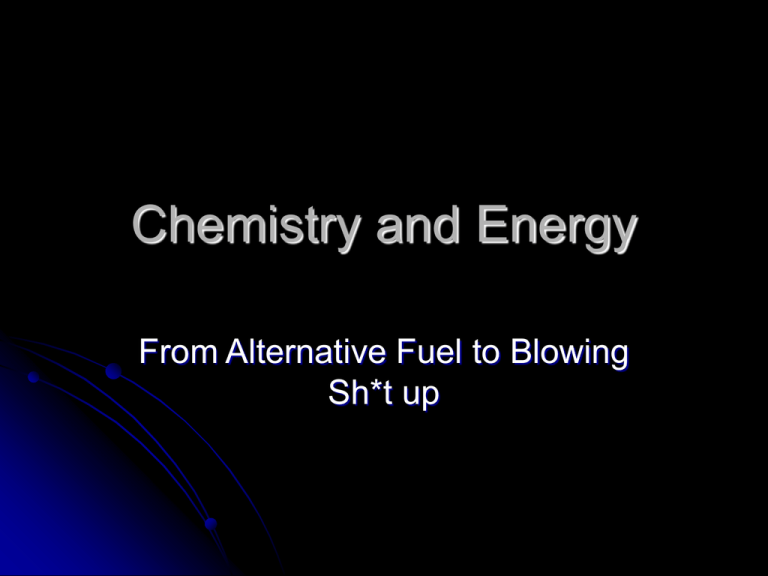
Chemistry and Energy From Alternative Fuel to Blowing Sh*t up Inorganic Chemistry and The Periodic Table Energy on Earth Octane – C8H18 2 C8H18 + 25 O2 18 H2O + 16 CO2 (unstable) (unstable) (stable) Release of energy Heat Work (pressure-volume work) (stable) Pressure-Volume work CO2 H2O CO2 O2 O2 O2 O2 O2 O2 H2O CO2 H2O CO2H2O CO2 H2O CO2 H2O CO 2 CH 8 8 Evidence of Pressure Volume Work –Liquid N2 Liquid N2: Boiling point, 77K, -196 0C, -321 0F For reference, the coldest temperature ever recorded was 184.0 K −89.2 °C (−128.6 °F;) at the Soviet Vostok Station in Antarctica on July 21, 1983. How does it work? It takes very little energy to vaporize liquid N2. (0.67 cal/mol, compared to water at 9.8 cal/mol). The heat from the tounge instantly vaporized liquid N2, protective barrier of insulating gas, which does work on the liquid, lifting it away from the tounge. Octane – an organic molecule with inorganic origins. Octane – Where did it come from? Fossil Fuel – Plant matter (C6H12O6) decaying away from O2 (buried organic matter) Where does sugar come from? 6 H2O + 6 CO2 C6H12O2 + 6 O2 (stable) (stable) (unstable) (unstable) The Energy comes from Light! Photosystem II Photosystem II CO2 Electron Transport Chain e+ e- + H+ C6H12O6 Photosystem II CO2 Electron Transport Chain e+ e- ++ H+ C6H12O6 Photosystem II CO2 Electron Transport Chain e+ e- + ++ H+ C6H12O6 Photosystem II CO2 Electron Transport Chain e+ H+ C6H12O6 2 H2O + hn 4 e- 4 H+ + O2 e- + ++ + + H+ HO e-e-e-e+ H+ HO Photosystem II-inspired solar fuel CO2 H+ Electron Transport Chain C6H12O6 2 H2O + hn 4 e- 4 H+ + O2 4 H+ + 4e- 2 H2 2 H2O + hn 2 H2 + O2 O2 H2 H+ Explosives 2 H2 + O2 H2O Effective explosive Solid Unstable Entirely converts to a gas (N2, CO2, H2O) Releases heat Low oxygen balance (self-contained oxidant) Examples: TNT RDX Octanitrocubane Octanitrocubane Nitro groups (oxidant) Carbon chains-fuel (like octane) Zero oxygen balance: Converts entirely to N2, CO2 C8O16N8 8 CO2 + 4 N2 (unstable) (stable) (stable) ON O ON O ON O C ON O C C C ON OC C C C ON O ON O ON O Inorganic explosives How do we get to the next level? Introduce new atoms! Thermite reaction 2 Al + Fe2O3 Al2O3 + 2 Fe (unstable) (moderate) (stable) (moderate) The Elements by Tom Lehrer There's antimony, arsenic, aluminum, selenium, And hydrogen and oxygen and nitrogen and rhenium, And nickel, neodymium, neptunium, germanium, And iron, americium, ruthenium, uranium, Europium, zirconium, lutetium, vanadium, And lanthanum and osmium and astatine and radium, And gold and protactinium and indium and gallium, And iodine and thorium and thulium and thallium. There's yttrium, ytterbium, actinium, rubidium, And boron, gadolinium, niobium, iridium, And strontium and silicon and silver and samarium, And bismuth, bromine, lithium, beryllium, and barium. There's holmium and helium and hafnium and erbium, And phosphorus and francium and fluorine and terbium, And manganese and mercury, molybdenum, magnesium, Dysprosium and scandium and cerium and cesium. And lead, praseodymium, and platinum, plutonium, Palladium, promethium, potassium, polonium, And tantalum, technetium, titanium, tellurium, And cadmium and calcium and chromium and curium. There's sulfur, californium, and fermium, berkelium, And also mendelevium, einsteinium, nobelium, And argon, krypton, neon, radon, xenon, zinc, and rhodium, And chlorine, carbon, cobalt, copper, tungsten, tin, and sodium. Electrical energy from inorganics – The Battery PbO2 + Pb + H2SO4 2 Pb(SO4) + 2 H2O unstable unstable (spectator) stable stable Pb4+ + Pb0 2 Pb2+ (stable) (stable) (unstable) 2 e- Pb2+ Pb2+ The Hydrogen Fuel Cell 2 H2 + O2 H2O (unstable) (unstable) (stable) e-e-- ee O O H2O H2O H+H++ + HH H H H H


